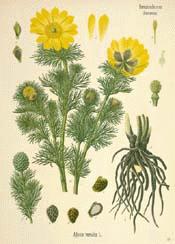

|
Spring Pheasant's Eye
(Adonis vernalis)
|
Hellebore, False
POISON!
Botanical: Adonis autumnalis, Adonis vernalis
Family: N.O. Ranunculaceae
---Synonyms---Red Chamomile. Pheasant's Eye. Adonis. Red Morocco. Rose-a-rubie. Red Mathes. Sweet Vernal.
---Part Used---Herb.
The Pheasant's Eye (Adonis autumnalis), a plant very nearly allied to the Anemone, is sometimes found wild in England, mostly in cornfields in Kent, but is often regarded as a mere garden escape. Though generally only a cultivated species in this country, it is common enough on the Continent.
It is a graceful plant, growing about a foot high, with finely cut leaves and terminal flowers like small scarlet buttercups.
---History---Its Latin name is derived from the ill-fated Adonis, from whose blood it sprang, according to the Greek legends. 'Red Morocco' was a somewhat strange old English name for this plant, also 'Rose-a-rubie' and 'Red Mathes,' 'by which name,' says Gerard, 'it is called of them that dwell where it groweth naturally and generally red camomill' - the latter on account of the finely-cut leaves. It is now aptly called Pheasant's Eye, on account of its brilliant little scarlet and black blossoms.
Although named A. autumnalis, it blossoms throughout the summer, commencing to flower in June, and the seeds ripen in August and September. It is an annual, propagated by its seeds, which may be sown at almost any season, but should always be sown where the plant is to grow, because it does not bear transplanting. Any soil will suit it: it blossoms more freely in the sunshine, but willalso flourish in shade.
In olden days it was considered to have some medicinal value, but is no longer used. Its near relative, A. vernalis (or 'Ox-eye'), though not officinal, is still regarded of medicinal value, and is a perennial species, not a native of this country, but common in central Europe, where its root is often used in the place of Black Hellebore.
'A. vernalis is one of the brightest and most effective of spring plants, known in many places as Sweet Vernal. It might be said of this, as of the Daffodil, that it "takes the winds of March with beauty," for often before the month is out it opens its rich, golden Anemone-like cups to the sun, and when planted in profusion, presents a glowing mass of colour. The plant is only about 9 inches high, and its foliage is one of its beauties. It makes a good addition to the rockery. Another species, A. amurensis, which is among the earliest of all the flowers, for it comes into bloom in February and March, is rather taller, and the foliage is more finely cut. There is a double variety, flore pleno, with large, yellow flowers. These plants will grow in any good garden soil, well drained and not too heavy. They should have a sunny position, but should not be allowed to suffer from drought during summer. They are quite hardy, and if left undisturbed improve from year to year.'
[Top]
---Constituents---A. vernalis contains a glucoside Adonidin and has an action almost exactly like that of digitalin, but is much stronger and is said not to be cumulative. It appears to be about ten times as powerful as digitoxin. It has been prescribed instead of digitalis, and sometimes succeeds where digitalis fails, especially where there is kidney disease. It is, however, less certainly beneficial in valvular disease than digitalis, and should be used only where digitalis fails. It produces vomiting and diarrhoea more readily than digitalis. It is given in the form of an infusion.
---Preparations and Dosages---Fluid extract, 1 to 2 drops. Glucoside adonidin, 1/4 to 1/2 grain.
The infusion is made with 1/4 oz. of the herb to a pint of boiling water and given in tablespoonful doses every three hours.
[Top]
Common Name Index
A MODERN HERBAL Home Page
Bear in mind "A Modern Herbal" was written with the conventional wisdom of the early 1900's. This should be taken into account as some of the information may now be considered inaccurate, or not in accordance with modern medicine.
© Copyright Protected 1995-2004 botanical.com

|



